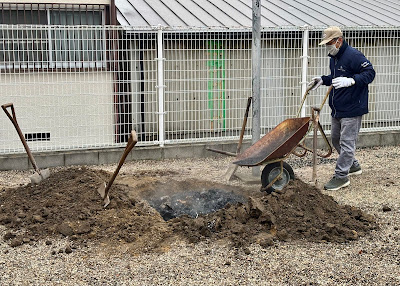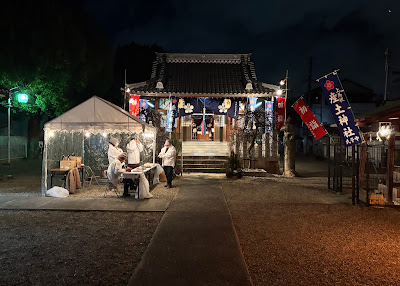On January 15, 2025, from 8:00 - 10:00 AM, we (the shrine elders and the recruited volutnteer/visual anthropologist) held the Tondo Matsuri at our local shrine, Ubusuna Jinja, in Shirogaki-cho, Kadoma-shi, Osaka-fu. This low key community based event is a chance for neighbors to bring their religious amulets from the previous year and new year's decorations to the shrine to be burned. Like Shinto itself, one might argue that this festival is more tradtional/cultural than religious in nature. I documented this same event at the shrine in 2013. Aside from a few changes, (fewer participants, older participants, no tobacco smokers or beer), this year's event was the same as it was in 2013 (as a good ritual should be...). Check out the 2013 post for more specifics about the Tondo Matsuri.
Tondo Festival - とんど祭り (1/15/13): https://visualanthropologyofjapan.blogspot.com/2013/01/tondo-festival.html
See also:
Remains of the 2018 Kayashima Shrine Tondo Festival (1/15/18): https://visualanthropologyofjapan.blogspot.com/2018/01/remains-of-2018-kayashima-shrine-tondo.html
Let's get back to Ubusuna Jinja in 2025...
Explorations and experiments in visual representations - multimodality, sensory ethnography, reflexivity, autoethnographic vignettes, ethnographic photography and ba...

Friday, January 17, 2025
Sunday, January 12, 2025
MASATO USHIMARU / RESEARCH-BASED PHOTOGRAPHY Photobook and Ethnographic Film: "OUR CO-BLIND"
PHOTOBOOK, OUR CO-BLIND - A Visual Ethnography of the Visually Impaired Community in the Northern Philippines
"OUR CO-BLIND -A Visual Ethnography of the Visually Impaired Community in the Northern Philippines" is a visual anthropological research project exploring the care practices and social movements among visually impaired communities in the northern Philippines. Grounded in years of fieldwork, photography, and filmmaking, the project combines sensory interventions with an ethnographic approach to uncover the community’s inner logic and forms of intimacy. Through dialogue and immersion in their sensory worlds via photography, the researcher collaborates with visually impaired interlocutors to philosophically examine what it truly means to “see better” beyond vision.
B5 size / 112 pages / Photography, Text and Design by Masato Ushimaru / Printed in Japan by inuunic / Published in Jan 2025
Website: https://studioboukei.square.site/product/photobook-our-co-blind-a-visual-ethnography-of-the-visually-impaired-community-in-the-northern-philippines/7
ETHNOGRAPHIC FILM "OUR CO-BLIND"
Summary (translated from webiste): Produced as the result of a research project for the Master's in Visual Anthropology at Aarhus University, Denmark, this work focuses on the autonomous community and social movement formed by visually impaired people living in the highland city of Baguio City and its surrounding areas in the province of Benguet in the northern Philippines. Starting with ethnography on care practices within the community of visually impaired people, the film depicts spontaneous and generative care relationships that are tailored to the situation, going beyond the binary role recognition of "caregiver" and "care recipient." Furthermore, it captures how the "bigger voices" that people with disabilities acquire by gathering together and sharing their lives are heard by the society of the northern Philippines and lead to social movements. There, the reality emerges that "care," which is often spoken of with an emotional and human impression, is an extremely logical and strategic act.
Title “Our Co-Blind - An Ethnography of Care among Visually Impaired Communities in Baguio”
Year of Production 2023
Country of Production Denmark
Duration 38min
Interlocutors Alfredo Esquillo, Shirley Esquillo, Domingo Regados, Junifer Ap-Ap, Jennifer Maysa (br /> Director / Editor Masato Ushimaru (Aarhus University, MSc in Visual Anthropology)
Translator Darleen Vee Bialno
Website: https://masatoushimaru.com/our-co-blind
"OUR CO-BLIND -A Visual Ethnography of the Visually Impaired Community in the Northern Philippines" is a visual anthropological research project exploring the care practices and social movements among visually impaired communities in the northern Philippines. Grounded in years of fieldwork, photography, and filmmaking, the project combines sensory interventions with an ethnographic approach to uncover the community’s inner logic and forms of intimacy. Through dialogue and immersion in their sensory worlds via photography, the researcher collaborates with visually impaired interlocutors to philosophically examine what it truly means to “see better” beyond vision.
B5 size / 112 pages / Photography, Text and Design by Masato Ushimaru / Printed in Japan by inuunic / Published in Jan 2025
Website: https://studioboukei.square.site/product/photobook-our-co-blind-a-visual-ethnography-of-the-visually-impaired-community-in-the-northern-philippines/7
ETHNOGRAPHIC FILM "OUR CO-BLIND"
Summary (translated from webiste): Produced as the result of a research project for the Master's in Visual Anthropology at Aarhus University, Denmark, this work focuses on the autonomous community and social movement formed by visually impaired people living in the highland city of Baguio City and its surrounding areas in the province of Benguet in the northern Philippines. Starting with ethnography on care practices within the community of visually impaired people, the film depicts spontaneous and generative care relationships that are tailored to the situation, going beyond the binary role recognition of "caregiver" and "care recipient." Furthermore, it captures how the "bigger voices" that people with disabilities acquire by gathering together and sharing their lives are heard by the society of the northern Philippines and lead to social movements. There, the reality emerges that "care," which is often spoken of with an emotional and human impression, is an extremely logical and strategic act.
Title “Our Co-Blind - An Ethnography of Care among Visually Impaired Communities in Baguio”
Year of Production 2023
Country of Production Denmark
Duration 38min
Interlocutors Alfredo Esquillo, Shirley Esquillo, Domingo Regados, Junifer Ap-Ap, Jennifer Maysa (br /> Director / Editor Masato Ushimaru (Aarhus University, MSc in Visual Anthropology)
Translator Darleen Vee Bialno
Website: https://masatoushimaru.com/our-co-blind
Tuesday, January 7, 2025
New Year's Eve 2024 / Early New Year's Day 2025「2024年大晦日から2025年元旦」
明けましておめでとうございます。今年もよろしくお願いします。
Happy New Year! VAoJ hopes for a wonderful, peaceful and meaningful 2025 for all!
Please forgive the lateness of our New Year's greetings. These photos span the time between New Year's Eve 2024 and the wee morning hours of New Year's Day 2025 at our local shrine, Ubusuna Jinjya (産土神社).
A few months ago, the shrine elders asked me to assist them with the preparations and activities during the new year holidays. They knew me because of my participation in the fall festival for the last several years, and because I was always taking photos at the shrine. They asked me, in part, because they are a small group of senior men who were looking for some young(er) blood to help out. I was extremely honored and promised to do whatever I could.
Preparations began on December 29. And we gathered again at the shrine at 10:30 PM on the 31st for the final provisions and to welcome worshipers and visitors who would be coming at midnight to offer their new year's prayers. Although I have gone to the shrine at midnight almost every year's eve for the last 20 years, I had no idea of the details and all the work involved to prepare the shrine. Despite their ages and various health problems, I found these older men to be strong, agile and most capable. I sort of felt like I was a kid again, assisting my father but not really knowing how to do anything.
At midnight, many people from the neighborhood started to arrive. Our shrine is a small one (now, anyway, in the past it was one of the largest and major shrines in the Kawachi region), but I estimate between 250 - 300 visitors came before we packed up and went home at 2:30 AM. My main duty was to assist in the preparation and serving of the omiki, or sacred sake.
While I was there to work for the shrine, I was able to take a few photos. I am grateful to the shrine elders for all of the work they have done for years for the benefit of our community. And I was grateful that I could assist, and do a little visual anthropology in between duties. In the following days I will post photos of the preparations for the event and the post-work we did on the morning on January 1.
Happy New Year! VAoJ hopes for a wonderful, peaceful and meaningful 2025 for all!
Please forgive the lateness of our New Year's greetings. These photos span the time between New Year's Eve 2024 and the wee morning hours of New Year's Day 2025 at our local shrine, Ubusuna Jinjya (産土神社).
A few months ago, the shrine elders asked me to assist them with the preparations and activities during the new year holidays. They knew me because of my participation in the fall festival for the last several years, and because I was always taking photos at the shrine. They asked me, in part, because they are a small group of senior men who were looking for some young(er) blood to help out. I was extremely honored and promised to do whatever I could.
Preparations began on December 29. And we gathered again at the shrine at 10:30 PM on the 31st for the final provisions and to welcome worshipers and visitors who would be coming at midnight to offer their new year's prayers. Although I have gone to the shrine at midnight almost every year's eve for the last 20 years, I had no idea of the details and all the work involved to prepare the shrine. Despite their ages and various health problems, I found these older men to be strong, agile and most capable. I sort of felt like I was a kid again, assisting my father but not really knowing how to do anything.
At midnight, many people from the neighborhood started to arrive. Our shrine is a small one (now, anyway, in the past it was one of the largest and major shrines in the Kawachi region), but I estimate between 250 - 300 visitors came before we packed up and went home at 2:30 AM. My main duty was to assist in the preparation and serving of the omiki, or sacred sake.
While I was there to work for the shrine, I was able to take a few photos. I am grateful to the shrine elders for all of the work they have done for years for the benefit of our community. And I was grateful that I could assist, and do a little visual anthropology in between duties. In the following days I will post photos of the preparations for the event and the post-work we did on the morning on January 1.
Subscribe to:
Posts (Atom)







































